Petrea volubilis, which comes from the New World, is, like Duranta repens, a classic in tropical gardens worldwide.
This robust vine, capable of reaching the tops of the tallest trees, has a marked gray woody bark with indentations. Its leaves are tough and very rough to the touch, to the extent that the French in the Caribbean call it “liane rude” (rough vine), and the English refer to it as “Sandpaper Vine”; they are elliptical, with fine, prominent veins and an entire margin. The flowers form upright, drooping, or pendant clusters measuring 30 to 45 cm; on this cluster, they are paired; their calyx is double, the first being brownish and truncated, and the second lilac or white, persisting for a long time while the 5 smaller, darker violet petals fall quickly. The fruit is nestled in the center of the calyx. Petrea volubilis, named after the English botanist Lord Robert James Petre (1713-1743), is now commonly sold by Laotian horticulturists. However, this beautiful vine does not seem to have another name here other than the one given by the Thais: tiao meuang.
Among the South American Indians (the Wayapi), the sap of Petrea is used to treat burns and wounds in general. In the Caribbean, in combination with other plants, it is used as an abortifacient.
For those interested in trying a new tool, they can, like the Native Americans, polish gourds and soft wood with the leaves of this rough vine.
Petrea volubilis qui nous vient du Nouveau Monde est, comme Duranta repens, une grande classique des jardins tropicaux du monde.
Cette forte liane qui peut atteindre le sommet des plus grands arbres, a une écorce grise ligneuse marquée d’anfractuosités. Ses feuilles sont coriaces, très râpeuses au toucher, au point que les Français de la Caraïbe la nomment liane rude, et les Anglais Sandpaper Vine (« liane papier de verre »); elles sont elliptiques, avec de fines nervures bien apparentes et une marge entière. Les fleurs forment des grappes dressées, penchées ou pendantes de 30 à 45cm; sur cette grappe elles sont opposées par deux; leur calice est double, le premier brunâtre, tronqué, le deuxième lilas ou blanc demeurant longtemps en place alors que les 5 pétales, bien plus petits, violet plus foncé, tombent rapidement. Le fruit est enchâssé au centre du calice.
Petrea volubilis qui doit son nom à lord Robert James Petre (1713-1743) botaniste anglais est maintenant vendu couramment par les horticulteurs lao mais cette belle liane ne semble pas avoir d’autre nom ici que celui que lui donnent les Thaï: tiao meuang.
Chez les Indiens d’Amérique du Sud (les Wayapi) la sève de Petrea est employée pour traiter les brûlures et les blessures en général. Dans la Caraïbe, en association avec d’autres plantes, elle sert d’abortif.
Pour ceux qui voudraient expérimenter un nouvel outil, ils peuvent, comme le font les Amérindiens, polir les calebasses, les gourdes et le bois tendre avec les feuilles de cette liane rude.
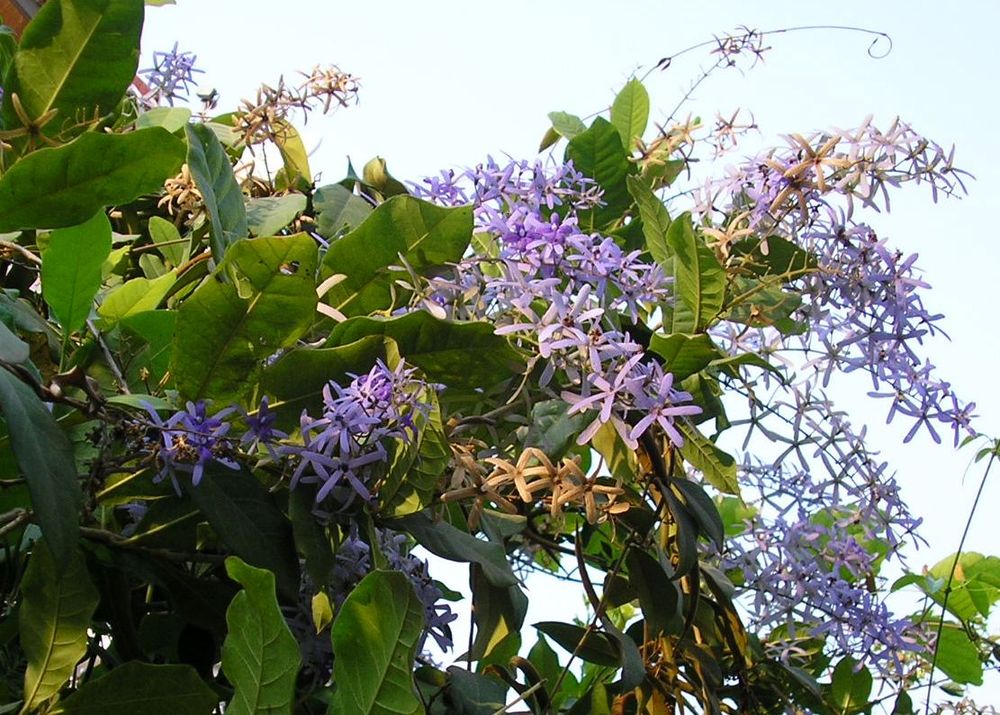
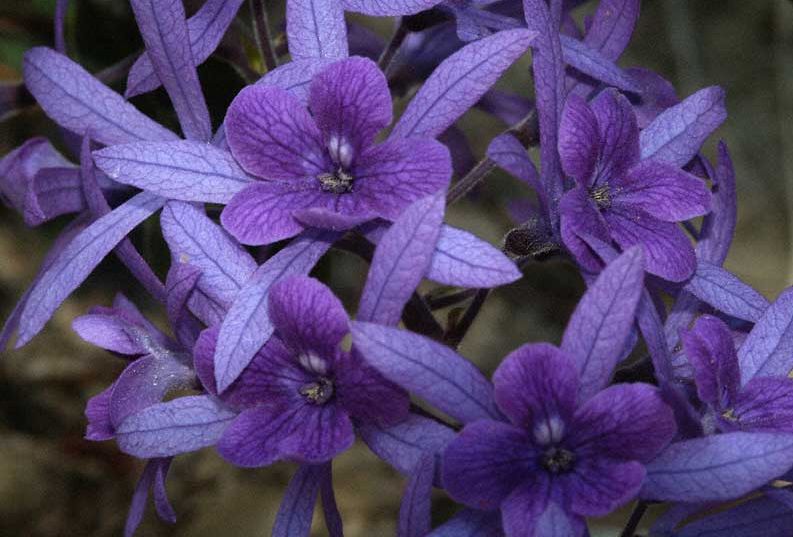
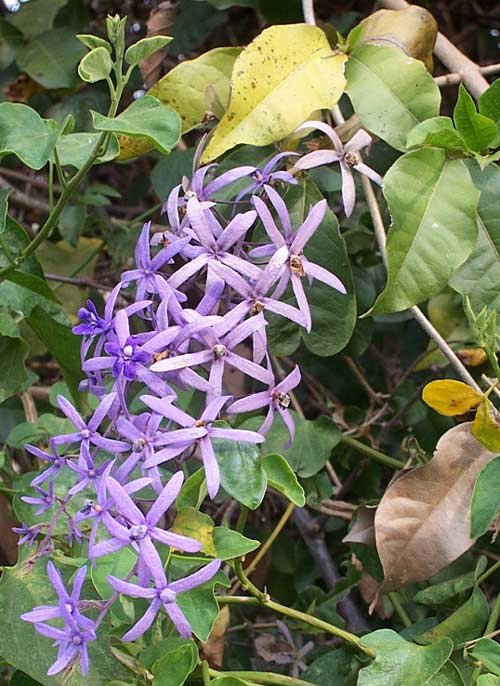
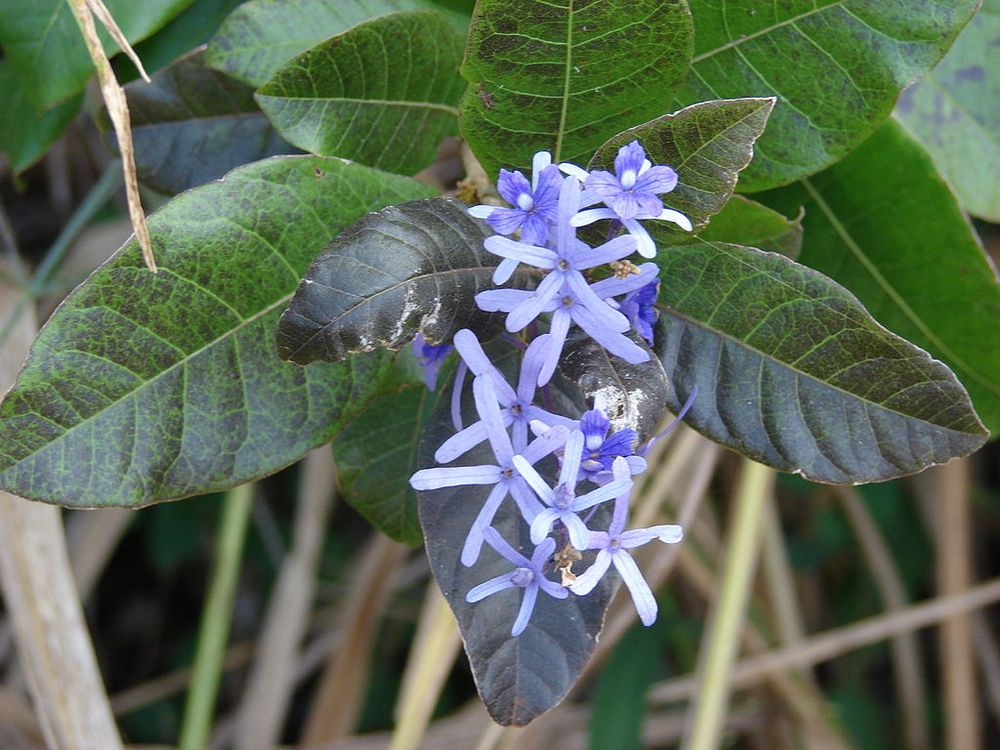
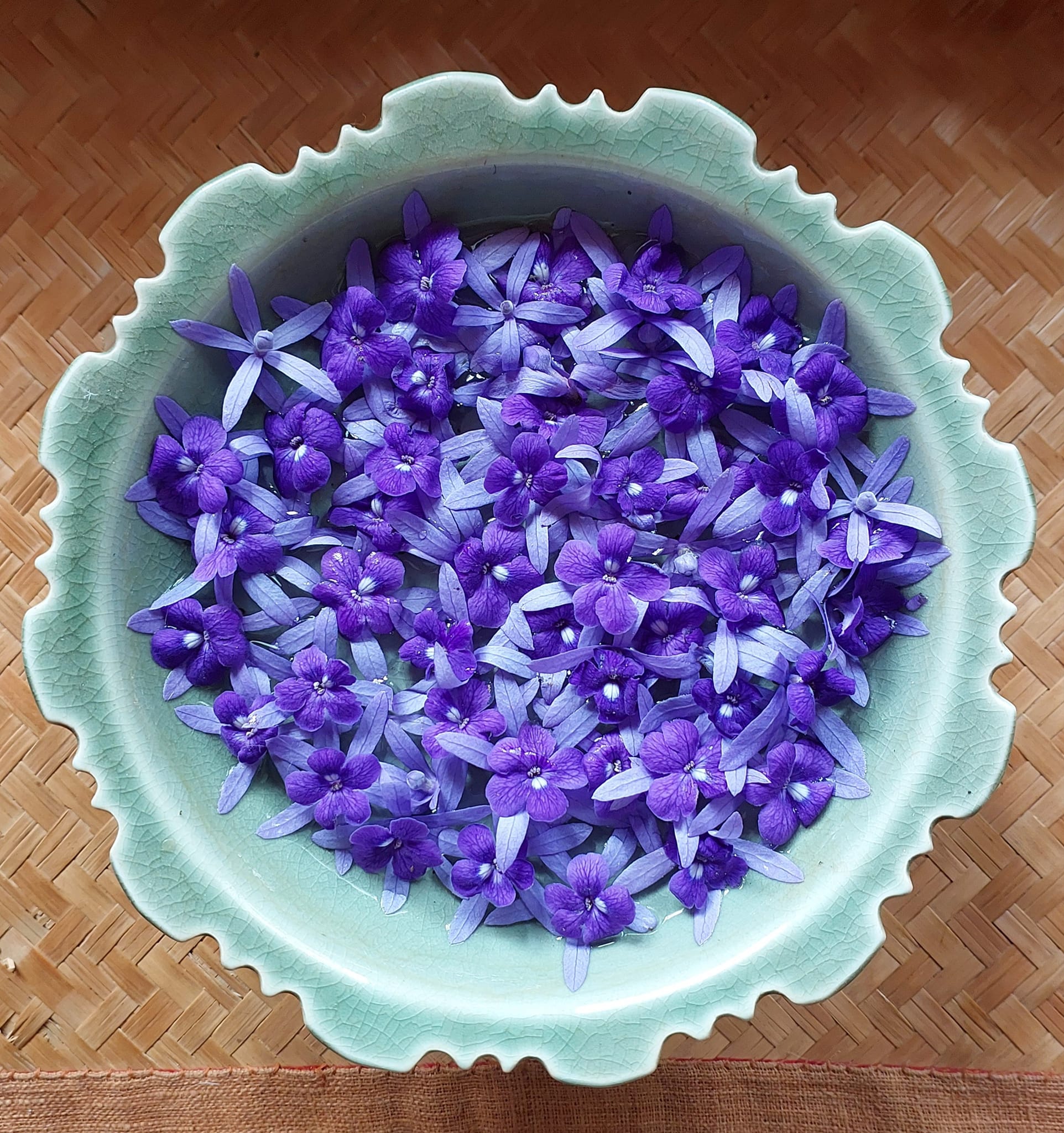
Petrea volubilis, which comes from the New World, is, like Duranta repens, a classic in tropical gardens worldwide.
This robust vine, capable of reaching the tops of the tallest trees, has a marked gray woody bark with indentations. Its leaves are tough and very rough to the touch, to the extent that the French in the Caribbean call it “liane rude” (rough vine), and the English refer to it as “Sandpaper Vine”; they are elliptical, with fine, prominent veins and an entire margin. The flowers form upright, drooping, or pendant clusters measuring 30 to 45 cm; on this cluster, they are paired; their calyx is double, the first being brownish and truncated, and the second lilac or white, persisting for a long time while the 5 smaller, darker violet petals fall quickly. The fruit is nestled in the center of the calyx. Petrea volubilis, named after the English botanist Lord Robert James Petre (1713-1743), is now commonly sold by Laotian horticulturists. However, this beautiful vine does not seem to have another name here other than the one given by the Thais: tiao meuang.
Among the South American Indians (the Wayapi), the sap of Petrea is used to treat burns and wounds in general. In the Caribbean, in combination with other plants, it is used as an abortifacient.
For those interested in trying a new tool, they can, like the Native Americans, polish gourds and soft wood with the leaves of this rough vine.
Petrea volubilis qui nous vient du Nouveau Monde est, comme Duranta repens, une grande classique des jardins tropicaux du monde.
Cette forte liane qui peut atteindre le sommet des plus grands arbres, a une écorce grise ligneuse marquée d’anfractuosités. Ses feuilles sont coriaces, très râpeuses au toucher, au point que les Français de la Caraïbe la nomment liane rude, et les Anglais Sandpaper Vine (« liane papier de verre »); elles sont elliptiques, avec de fines nervures bien apparentes et une marge entière. Les fleurs forment des grappes dressées, penchées ou pendantes de 30 à 45cm; sur cette grappe elles sont opposées par deux; leur calice est double, le premier brunâtre, tronqué, le deuxième lilas ou blanc demeurant longtemps en place alors que les 5 pétales, bien plus petits, violet plus foncé, tombent rapidement. Le fruit est enchâssé au centre du calice.
Petrea volubilis qui doit son nom à lord Robert James Petre (1713-1743) botaniste anglais est maintenant vendu couramment par les horticulteurs lao mais cette belle liane ne semble pas avoir d’autre nom ici que celui que lui donnent les Thaï: tiao meuang.
Chez les Indiens d’Amérique du Sud (les Wayapi) la sève de Petrea est employée pour traiter les brûlures et les blessures en général. Dans la Caraïbe, en association avec d’autres plantes, elle sert d’abortif.
Pour ceux qui voudraient expérimenter un nouvel outil, ils peuvent, comme le font les Amérindiens, polir les calebasses, les gourdes et le bois tendre avec les feuilles de cette liane rude.










Petrea volubilis, which comes from the New World, is, like Duranta repens, a classic in tropical gardens worldwide.
This robust vine, capable of reaching the tops of the tallest trees, has a marked gray woody bark with indentations. Its leaves are tough and very rough to the touch, to the extent that the French in the Caribbean call it “liane rude” (rough vine), and the English refer to it as “Sandpaper Vine”; they are elliptical, with fine, prominent veins and an entire margin. The flowers form upright, drooping, or pendant clusters measuring 30 to 45 cm; on this cluster, they are paired; their calyx is double, the first being brownish and truncated, and the second lilac or white, persisting for a long time while the 5 smaller, darker violet petals fall quickly. The fruit is nestled in the center of the calyx. Petrea volubilis, named after the English botanist Lord Robert James Petre (1713-1743), is now commonly sold by Laotian horticulturists. However, this beautiful vine does not seem to have another name here other than the one given by the Thais: tiao meuang.
Among the South American Indians (the Wayapi), the sap of Petrea is used to treat burns and wounds in general. In the Caribbean, in combination with other plants, it is used as an abortifacient.
For those interested in trying a new tool, they can, like the Native Americans, polish gourds and soft wood with the leaves of this rough vine.
Petrea volubilis qui nous vient du Nouveau Monde est, comme Duranta repens, une grande classique des jardins tropicaux du monde.
Cette forte liane qui peut atteindre le sommet des plus grands arbres, a une écorce grise ligneuse marquée d’anfractuosités. Ses feuilles sont coriaces, très râpeuses au toucher, au point que les Français de la Caraïbe la nomment liane rude, et les Anglais Sandpaper Vine (« liane papier de verre »); elles sont elliptiques, avec de fines nervures bien apparentes et une marge entière. Les fleurs forment des grappes dressées, penchées ou pendantes de 30 à 45cm; sur cette grappe elles sont opposées par deux; leur calice est double, le premier brunâtre, tronqué, le deuxième lilas ou blanc demeurant longtemps en place alors que les 5 pétales, bien plus petits, violet plus foncé, tombent rapidement. Le fruit est enchâssé au centre du calice.
Petrea volubilis qui doit son nom à lord Robert James Petre (1713-1743) botaniste anglais est maintenant vendu couramment par les horticulteurs lao mais cette belle liane ne semble pas avoir d’autre nom ici que celui que lui donnent les Thaï: tiao meuang.
Chez les Indiens d’Amérique du Sud (les Wayapi) la sève de Petrea est employée pour traiter les brûlures et les blessures en général. Dans la Caraïbe, en association avec d’autres plantes, elle sert d’abortif.
Pour ceux qui voudraient expérimenter un nouvel outil, ils peuvent, comme le font les Amérindiens, polir les calebasses, les gourdes et le bois tendre avec les feuilles de cette liane rude.


